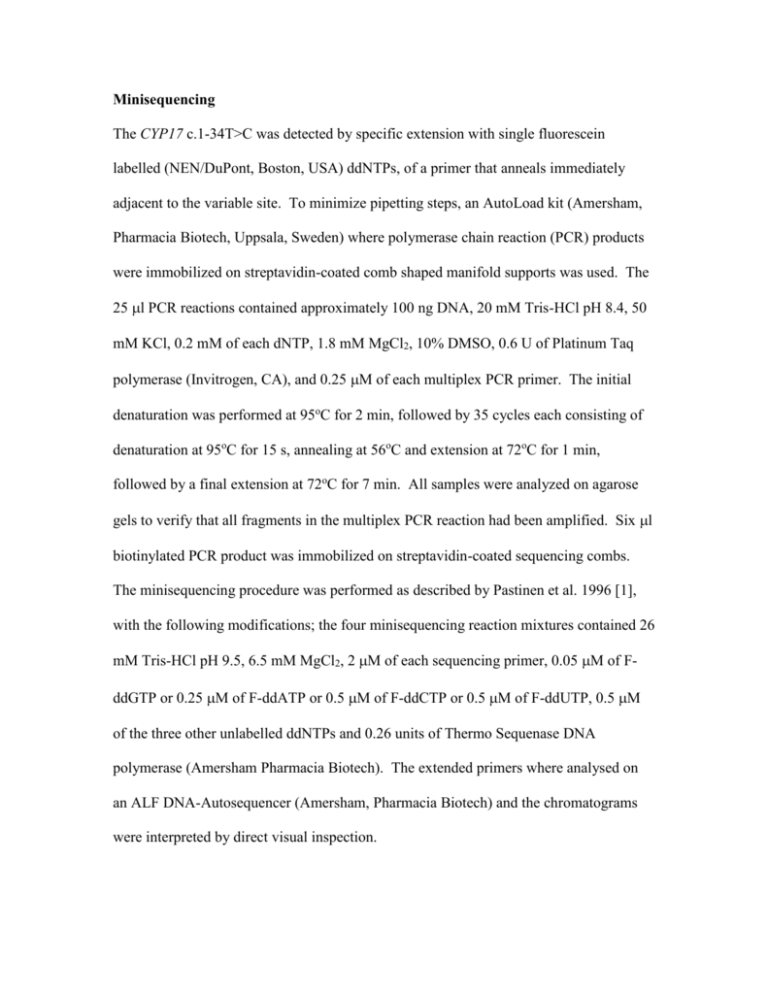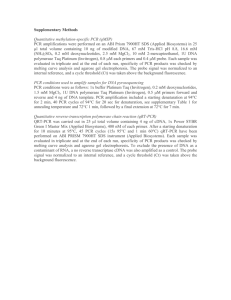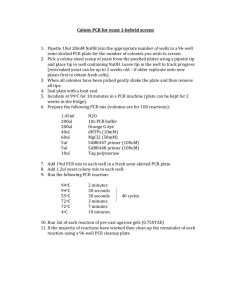Minisequencing - BioMed Central
advertisement

Minisequencing The CYP17 c.1-34T>C was detected by specific extension with single fluorescein labelled (NEN/DuPont, Boston, USA) ddNTPs, of a primer that anneals immediately adjacent to the variable site. To minimize pipetting steps, an AutoLoad kit (Amersham, Pharmacia Biotech, Uppsala, Sweden) where polymerase chain reaction (PCR) products were immobilized on streptavidin-coated comb shaped manifold supports was used. The 25 l PCR reactions contained approximately 100 ng DNA, 20 mM Tris-HCl pH 8.4, 50 mM KCl, 0.2 mM of each dNTP, 1.8 mM MgCl2, 10% DMSO, 0.6 U of Platinum Taq polymerase (Invitrogen, CA), and 0.25 M of each multiplex PCR primer. The initial denaturation was performed at 95oC for 2 min, followed by 35 cycles each consisting of denaturation at 95oC for 15 s, annealing at 56oC and extension at 72oC for 1 min, followed by a final extension at 72oC for 7 min. All samples were analyzed on agarose gels to verify that all fragments in the multiplex PCR reaction had been amplified. Six l biotinylated PCR product was immobilized on streptavidin-coated sequencing combs. The minisequencing procedure was performed as described by Pastinen et al. 1996 [1], with the following modifications; the four minisequencing reaction mixtures contained 26 mM Tris-HCl pH 9.5, 6.5 mM MgCl2, 2 M of each sequencing primer, 0.05 M of FddGTP or 0.25 M of F-ddATP or 0.5 M of F-ddCTP or 0.5 M of F-ddUTP, 0.5 M of the three other unlabelled ddNTPs and 0.26 units of Thermo Sequenase DNA polymerase (Amersham Pharmacia Biotech). The extended primers where analysed on an ALF DNA-Autosequencer (Amersham, Pharmacia Biotech) and the chromatograms were interpreted by direct visual inspection. DASH The PCR mix contained 10 ng DNA, 15 mM Tris-HCl pH 8.0, 50 mM KCl, 0.12 M biotinylated 5´-primer, 0.6 M 3´-primer (Table 1), 0.2 mM of each dNTP (HPLC purified, Interactiva GmbH, Ulm, Germany), 3.0 mM MgCl2, 5% DMSO, 0.6 units of AmpliTaq GOLD polymerase (Applied Biosystems, Foster City, CA) in a total volume of 25 l. The initial denaturation was performed at 95oC for 10 min, followed by 38 cycles each consisting of denaturation at 95oC for 15 s and annealing at 60oC for 30 s, followed by a final extension at 72oC for 4 min. PCR products were checked on 2% low-melting agarose gels. DASH assays were performed as described by Prince et al. 2001 [2] and genotypes were scored from fluorescence curves as described by Howell et al. 1999 [3]. References 1. Pastinen T, Partanen J, Syvanen AC: Multiplex, fluorescent, solid-phase minisequencing for efficient screening of DNA sequence variation. Clin Chem 1996, 42:1391-7. 2. Prince JA, Feuk L, Howell WM, Jobs M, Emahazion T, Blennow K, Brookes AJ: Robust and accurate single nucleotide polymorphism genotyping by dynamic allelespecific hybridization (DASH): design criteria and assay validation. Genome Res 2001, 11:152-62. 3. Howell WM, Jobs M, Gyllensten U, Brookes AJ: Dynamic allele-specific hybridization. A new method for scoring single nucleotide polymorphisms. Nat Biotechnol 1999, 17:87-8. Table 1. Primers and probes used for genotyping CYP17 c.1-34T>C 5’ – 3’ PCR primers Minisequencing Forward AGTCAAGGTGAAGATCAGGG Reverse Bio-GCTCTTGGGGTACTTGGCAC Forward Bio-GAGTTGCCAGAGCTCTTCTAC Reverse GGTGCCGGCAGGCAAGATAGA Minisequencing Extension primer AGAGTTGCCACAGCTCTTCTACTCCAC DASH Wildtype TAGACAGCAGTGGAGTA Mutant TAGACAGCGGTGGAGTA DASH Probes








